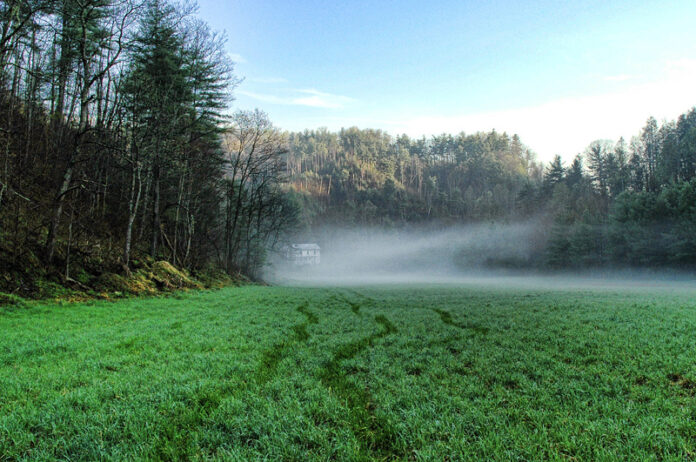
Spring comes with agonizing slowness in the mountains of Virginia. (My mother in Alabama says the jonquils are in full bloom there already.) We watch for signs of change from our windows, and one of the first we expect to see from the house is the faint greening of the grass tips in the pasture across the road.
Even now, through the deep quilt of winter snow, the longer hours of daylight are bringing the grasses slowly to life. Soon the tips of maples along the valley’s edge will show the faintest hint of dark ruby and rust, and earth will rise from her long hibernation with a rush.
March—the month named after Mars, the god of war—is when winter and spring do battle, and we know who will win. We just don’t know when. It is a struggle we know well as we imagine green grasses smothered under the longest winter of our lives. My how the view has changed.
The first March here on Goose Creek, our only level acres remained as we found them: choked with 13-year-old white pine trees. So many were crowded into our narrow valley that we supposed the planters had been paid by the tree. The owners of this land must have had the intention to maintain them as future Christmas trees, but after the planting, the pines were neglected.
When we first laid eyes on this land, they grew tall and spindly in long dreary, deadly-straight rows. Each tree’s whorled branches were without needles almost to the top, starved of light by the nearest neighbors. Rank and file they filled the flood plain of our other water source – “Nameless Creek” – flowing on around the bend of the valley.
The next March, our neighbors with the backhoe began the slow process of pushing down the pine poles that were by then twenty feet tall. No one wanted them for pulp or tips and they would never produce marketable timber, save a few around the perimeter that would get light.
Through that spring and into the summer, as we put back little bits of “extra” money, the boys would come and doze-then-burn another acre or fraction of an acre—whatever we could afford. By the fall, what had been a derelict pine thicket was a bare, rough and muddy plane.
But we imagined it green and inviting—someday. In October, we scattered 300 pounds of rye by hand on a raw day with a strong wind at our backs—five acres of seeds—and waited for the rains to come.
In March of our fourth year, the rye came up ever so slowly from the cold ground. With the warm days of May and June, it surged waist high and our muddy flat began to look like the pasture we’d imagined. In July, at dusk when ground fog hung over the valley floor and the fireflies rose in the warm dark, deer moved like ghosts in the shoulder high grain.
Our neighbor, who had cut hay off this place long before it grew up in pines, put down lime the fifth March in the new life of our reclaimed field. In May, he drilled in a mix of orchard grass and clover. In the fall, as if they’d sprung up overnight like mushrooms from our new pasture, seventeen large round bales lay in a kind of organic Stonehenge.
From the far end of the grassy floodplain, we look back down the narrow valley over the flat earth and see the barn and garden shed below the north ridge. At dusk from the middle of the clearing, golden light glows from inside our house. And overhead, more of Heaven swirls around me than I can comprehend.
This is our tenth early-spring of belonging to this land. Ann, the dog and I walk up the field we’ve come to know, along the creek and back every day. The green peace here feels as if it has always been just so, waiting for us to come into the open, our field of dreams.
By Fred First [email protected]

